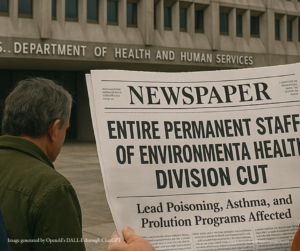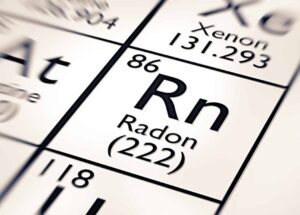Did you know that the month of May is National Allergy and Asthma Awareness month? According to the American Lung Association, more than 65 million Americans suffer from a combination of allergy and asthma symptoms, May being one of the worst months for these conditions. Asthma specifically, greatly impacts the overall health and quality of life in children. It is the leading chronic childhood disease with about 5.1 million children having been diagnosed as asthmatic. Child-care facilities are uniquely impacted by the prevalence of asthma and allergies, in that many children spend more time there then they do anywhere else. Studies have shown that an estimated 41 percent of American families have children that spend 35 hours or more in child-care per week. For this reason, the types of products used in early learning centers and potential exposures to toxins in these products play a big role in the health of our children.

Both asthma and allergies cause inflammation and irritation in the airways and nasal passages, making it more difficult to breathe as well as potentially causing long-term scar tissue on the lungs. Children are uniquely sensitive to inhaled irritants, making them at higher risk to develop negative symptoms of asthma and allergies. Children take in about double the amount of breaths that adults do, and have a larger lung surface area, making their airways more sensitive than an adults’ might be. Although children are very sensitive to these products, it is important to remember that growing babies can be impacted by these chemicals in utero as well. Both asthma and allergies can be managed with simple routine changes such as modifications to the way we clean as well as the types of products we use.
Types of Cleaning
Before deciding which products are safest to use, it is important to understand when is most appropriate to use them. Although the term “cleaning” is generally used to describe the process of eliminating germs within certain spaces, it is important to be able to differentiate between the different types as well as when they are most effective. Following this general guide will ensure that you are not only eliminating germs in the safest way, but that you are getting the most out of your cleaning.
Cleaning should generally be done daily using a combination of regular detergent and water. Cleaning is the first line of defense in removing germs on commonly used surfaces.
Sanitizing reduces the number of germs on a surface, simply making the amount of active germs acceptable according to certain health regulations. Sanitizers are most important for use on items that come in contact with children’s mouths or saliva.
Disinfectant makes germs completely inactive, and can be used to kill most germs on surfaces that are not porous in texture. Disinfectant is more appropriate for spaces like countertops or bathroom surfaces.
Why Green Cleaning?
There are many benefits to implementing a green cleaning plan, but one of the most pronounced is lung health. Studies have shown that asthma in both adults and children is linked to cleaning products, and the frequent use of cleaning sprays can be as impactful on the lungs as smoking a pack of cigarettes daily. Additionally, the use of many commercial disinfectants can decrease the good bacteria in your body, consequently weakening the immune system and contributing to the development of asthma and allergies. Having a green cleaning plan has been shown to decrease asthma flare ups and allergic reactions in both children and adults. This means increased attendance for children, less absenteeism for staff who might be suffering from these conditions, and ultimately communicates to parents that your center is interested in the best possible care for their children.
Many commonly used cleaning products contain harmful chemicals, in some cases even those that are labeled as “Green” or “Eco-friendly”. Cleaning products are traditionally much less regulated than other chemicals, and all of the ingredients are not always listed on the label. Regulations only require ingredients to be listed if the product contains more than 2 percent of that ingredient. It is ideal to choose cleaning solutions that contain as few active ingredients as possible.
Key Things to Avoid
- Most labels with ingredients that are unfamiliar to you should be avoided. If you have never heard of it, it most likely should not be in your cleaning products.
- Products that have fragrances or perfumes, even if they are “natural” scents. These not only cause asthma flare ups and allergy irritation, but they can also cause endocrine disorders that exacerbate asthma symptoms.
- Mixing products together when cleaning as they can produce more toxic gases.
- Using products containing ammonia or bleach, which worsen asthma symptoms and irritate both the throat and lungs.
Common commercial grade cleaners can in many cases be replaced by at home ingredients. The key when it comes to deciding the safest cleaning product to purchase is to look at the label. If there are many different ingredients listed that are unfamiliar to you, that product is most likely not eco-healthy or safe. Instead choose hydrogen peroxide or alcohol based products, that do not have any scent or perfumes. If you are trying to make a similar product yourself, baking soda and vinegar is a great starting point. This combination is a natural disinfectant, and can be used on any surface. It can also be used for scrubbing or polishing because of baking soda’s course texture. Additionally, if the goal is to remove odors, this can be done naturally by opening screened windows, or increasing ventilation by turning on exhaust fans. You can also safely remove unwanted smells by purchasing charcoal filters which will absorb the odors as well.
Although there are some improvements being made in terms of cleaning products and the toxins they contain, we have only scratched the surface of how these chemicals can impact our health, and the health of our kids. WHE recognizes that although it can be overwhelming to completely overhaul your routine in a shift towards Eco-Healthy, there are small steps you can take towards improving the quality of life for the children in your center as well as your staff. By being more conscious of the ingredients that are in the cleaners you purchase, you are not only protecting the lungs and airways of the children in your care, but your own as well without too much disruption or added effort. The changes are small, but the impact is significant!
References:
https://cehn.org/wp-content/uploads/2019/01/Household_chemicals_1_19.pdf
https://www.lung.org/clean-air/at-home/indoor-air-pollutants/cleaning-supplies-household-chem






